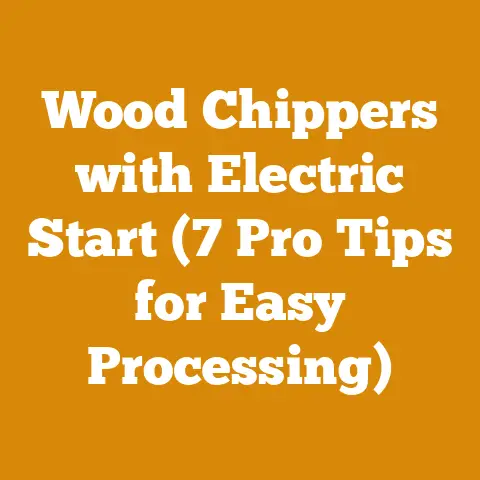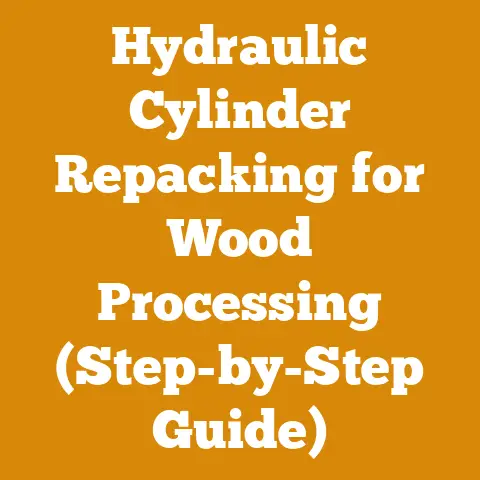Drum vs Disc Chipper: Which Reigns for VA Trees? (5 Pro Tips)
Let’s dive in!
The Heartwood’s Tale: Choosing the Right Chipper for Virginia’s Bounty
Have you ever held a piece of Osage Orange, also known as Bois d’Arc? It’s a wood so dense and resilient, it practically sings a song of defiance against the blade. I remember the first time I tried splitting a seasoned round of it. My maul bounced back with a resounding thunk, and I knew I was in for a battle. That experience, like so many others in my journey with wood, taught me the importance of choosing the right tool for the job. But which type should you choose: drum or disc? Especially here in Virginia, where we have everything from delicate dogwoods to stubborn oaks, the right choice can make all the difference.
Key Takeaways:
- Drum Chippers: Excel at processing larger diameter materials and handle variable feed well. They’re often more robust and can handle tougher jobs.
- Disc Chippers: Typically more efficient for smaller diameter, consistent material, and often offer a cleaner chip.
- Virginia Tree Species: The diverse range of hardwoods and softwoods in Virginia demands a chipper that can handle a variety of wood types and sizes.
- Job Size Matters: Consider the scale of your typical projects. Are you clearing land, managing a small woodlot, or just cleaning up after storms?
- Safety First: Always prioritize safety when operating any wood processing equipment. Proper training and adherence to safety guidelines are essential.
My First Encounter with a Wood Chipper: A Cautionary Tale
Before we delve into the nitty-gritty of drum vs. disc chippers, let me share a story. It was back in my early days of landscaping, and we had a massive job clearing a property overgrown with Virginia creeper and volunteer saplings. Our boss, bless his heart, rented a disc chipper that, shall we say, wasn’t exactly top-of-the-line.
We were feeding it a tangled mess of vines and branches when, suddenly, the whole thing seized up with a horrifying screech. Turns out, a thick vine had wrapped around the disc, bringing everything to a grinding halt. It took us hours to disassemble the machine and clear the jam.
That day, I learned two valuable lessons: first, always properly prepare your material before feeding it into a chipper; and second, understand the limitations of your equipment. Now, let’s get a better understanding of the difference between the two types of chippers.
Understanding Drum Chippers: The Workhorse of Wood Processing
Drum chippers are the heavy hitters of the chipping world. They use a rotating drum equipped with knives to pull material into the machine and chip it against an anvil. Think of it like a giant, wood-hungry grinder.
How Drum Chippers Work
A drum chipper’s functionality hinges on a horizontally mounted steel drum. This drum is fitted with multiple cutting blades (knives) arranged around its circumference. As the drum rotates at high speed, the knives shear the wood against a stationary anvil or counter blade. The infeed system, usually consisting of rollers or a conveyor belt, feeds the material towards the rotating drum. The drum’s rotation pulls the material in, and the knives chop it into chips. The size of the chips is determined by the knife spacing and the gap between the knives and the anvil.
Advantages of Drum Chippers
- Larger Material Capacity: Drum chippers can typically handle larger diameter branches and even small trees more easily than disc chippers. This makes them ideal for land clearing and storm cleanup.
- Handles Variable Feed Well: They are less prone to jamming when fed a mix of materials, including branches with forks and bends.
- Durability: Drum chippers are generally built tougher, designed to withstand the rigors of heavy use.
- Cost-Effectiveness: Often more affordable to buy and maintain, particularly for larger-capacity models.
Disadvantages of Drum Chippers
- Chip Quality: The chips produced by drum chippers can be less uniform in size and shape compared to disc chippers.
- Fuel Consumption: They tend to consume more fuel due to the larger rotating mass and higher power requirements.
- Size and Weight: Drum chippers are typically larger and heavier, making them less maneuverable.
- Noise: Can be louder than disc chippers.
Drum Chipper Applications in Virginia
In Virginia, where we often deal with dense hardwoods like oak and hickory, drum chippers are a popular choice for:
- Land Clearing: Removing trees and brush for construction or agricultural purposes.
- Storm Cleanup: Processing fallen trees and branches after hurricanes or ice storms.
- Right-of-Way Maintenance: Clearing vegetation along roadsides and power lines.
- Municipal Use: City and county crews use drum chippers for tree trimming and park maintenance.
Expert Insight:
“Drum chippers are the workhorses of the industry,” says Mark Johnson, a certified arborist with 20 years of experience in Richmond. “They can handle just about anything you throw at them. I’ve seen them chew through whole trees, roots and all.”
Case Study: A Virginia Land Clearing Project
A local land developer in Charlottesville needed to clear a 5-acre plot of land covered in a mix of hardwoods and pines. They opted for a drum chipper due to its ability to handle the large diameter trees and the variable nature of the vegetation. The drum chipper efficiently processed the trees and brush, reducing the volume of material that needed to be hauled off-site. This saved the developer time and money on disposal costs.
Disc Chippers: Precision and Efficiency in Chipping
Disc chippers, on the other hand, are known for their precision and efficiency. They use a rotating disc with knives mounted on its surface to chip material. Imagine a giant, spinning razor blade slicing through wood.
How Disc Chippers Work
Disc chippers feature a large, flat steel disc that rotates on a vertical or near-vertical axis. Cutting knives are mounted on the face of this disc, and as the disc spins, these knives slice the wood into chips. The infeed system pushes the material towards the spinning disc, and the knives shave off chips as the wood passes by. The angle of the knives and the speed of the disc determine the size and shape of the chips.
Advantages of Disc Chippers
- Chip Quality: Disc chippers produce more uniform and consistent chips, which are ideal for landscaping, mulch, and composting.
- Fuel Efficiency: Generally more fuel-efficient than drum chippers, especially for smaller diameter material.
- Portability: Often smaller and lighter than drum chippers, making them easier to transport and maneuver.
- Quieter Operation: Typically quieter than drum chippers.
Disadvantages of Disc Chippers
- Material Size Limitations: Disc chippers struggle with larger diameter branches and trees.
- Susceptible to Jams: More prone to jamming when fed tangled or irregular material.
- Maintenance: Can require more frequent maintenance due to the higher speeds and tighter tolerances.
- Cost: Can be more expensive than drum chippers, especially for larger-capacity models.
Disc Chipper Applications in Virginia
In Virginia, disc chippers are well-suited for:
- Residential Tree Service: Trimming and removing trees in residential areas where noise and maneuverability are concerns.
- Landscaping: Producing high-quality wood chips for mulch and landscaping projects.
- Orchard and Vineyard Maintenance: Pruning and removing branches in orchards and vineyards.
- Small-Scale Woodlot Management: Processing smaller trees and branches in managed woodlots.
Expert Insight:
“If you’re looking for consistent, high-quality chips, a disc chipper is the way to go,” says Sarah Miller, a landscape designer in Norfolk. “The chips are perfect for mulching flower beds and creating natural pathways.”
Case Study: A Virginia Landscaping Company
A landscaping company in Richmond uses a disc chipper to process tree trimmings and create mulch for their clients. The disc chipper produces uniform chips that are aesthetically pleasing and provide excellent weed control. The company has found that using their own mulch saves them money on material costs and allows them to offer a more sustainable service to their clients.
5 Pro Tips for Choosing the Right Chipper for Virginia Trees
Now that we’ve covered the basics of drum and disc chippers, let’s dive into some pro tips to help you make the right choice for your specific needs in Virginia.
Tip 1: Assess Your Typical Material
What kind of trees and branches do you typically process? Are you dealing with large diameter hardwoods, smaller softwoods, or a mix of both?
- Large Hardwoods (Oak, Hickory, Maple): Drum chippers are generally better suited for these tougher materials.
- Smaller Softwoods (Pine, Cedar, Poplar): Disc chippers can handle these materials efficiently.
- Mixed Materials: Consider a drum chipper with a variable feed rate to handle a range of material sizes.
Data Point: According to the Virginia Department of Forestry, hardwoods make up approximately 70% of the state’s forestland. This suggests that a chipper capable of handling hardwoods is a wise investment for many Virginians.
Tip 2: Consider Your Job Size and Frequency
How often will you be using the chipper, and how much material will you be processing each time?
- Occasional Use (Homeowners): A smaller, portable disc chipper might be sufficient.
- Frequent Use (Landscapers, Tree Services): A larger, more robust drum or disc chipper is recommended.
- High-Volume Use (Land Clearing, Municipalities): A heavy-duty drum chipper with a high-capacity engine is essential.
Personal Anecdote: I once tried to use a small electric disc chipper to clean up after a major ice storm. It quickly became overwhelmed by the sheer volume of branches, and I ended up spending more time clearing jams than actually chipping. Lesson learned: always match the chipper to the job.
Tip 3: Evaluate Portability and Storage
Do you need to move the chipper frequently between job sites? Do you have limited storage space?
- Portable Chippers: Smaller disc chippers are often mounted on wheels for easy transport.
- Towable Chippers: Larger drum and disc chippers can be towed behind a truck or tractor.
- Self-Propelled Chippers: Some chippers are self-propelled, allowing them to navigate rough terrain.
Practical Tip: Before buying a chipper, measure your storage space to ensure it will fit comfortably. Also, consider the weight of the chipper and whether you have the appropriate vehicle for towing it.
Tip 4: Factor in Maintenance and Repair Costs
All chippers require regular maintenance, including blade sharpening, oil changes, and belt replacements. Research the availability of parts and service in your area.
- Blade Sharpening: Dull blades can significantly reduce chipping efficiency and increase fuel consumption. Learn how to sharpen your chipper blades properly or hire a professional.
- Preventive Maintenance: Follow the manufacturer’s recommended maintenance schedule to prevent costly repairs.
- Local Service: Choose a chipper brand with a strong local service network.
Industry Data: A study by the Equipment Dealers Association found that the average annual maintenance cost for a wood chipper is between 5% and 10% of the purchase price.
Tip 5: Prioritize Safety
Operating a wood chipper can be dangerous. Always wear appropriate safety gear, including eye protection, hearing protection, gloves, and sturdy boots.
- Read the Manual: Familiarize yourself with the chipper’s operating instructions and safety precautions.
- Wear Safety Gear: Always wear appropriate safety gear, including eye protection, hearing protection, gloves, and sturdy boots.
- Clear the Area: Keep bystanders and pets away from the chipper while it is in operation.
- Never Reach In: Never reach into the chipper while it is running. Use a push stick to feed material into the machine.
- Emergency Stop: Know the location of the emergency stop switch and how to use it.
- Training: Consider taking a safety course on wood chipper operation.
Expert Quote:
“Safety should always be your top priority when operating a wood chipper,” says David Brown, a safety consultant specializing in forestry equipment. “A moment of carelessness can have devastating consequences.”
Drum vs. Disc Chipper: A Head-to-Head Comparison Table
To summarize the key differences between drum and disc chippers, here’s a handy comparison table:
| Feature | Drum Chipper | Disc Chipper |
|---|---|---|
| Material Size | Handles larger diameter materials | Limited to smaller diameter materials |
| Material Type | Handles variable feed well | More prone to jams with tangled material |
| Chip Quality | Less uniform chips | More uniform, high-quality chips |
| Fuel Efficiency | Lower fuel efficiency | Higher fuel efficiency |
| Portability | Generally larger and heavier | Often smaller and more portable |
| Noise | Louder | Quieter |
| Maintenance | Generally less frequent maintenance | Can require more frequent maintenance |
| Cost | Often more affordable | Can be more expensive |
| Best Use | Land clearing, storm cleanup, heavy-duty use | Landscaping, residential tree service, mulch |
Beyond the Basics: Advanced Considerations
Once you’ve narrowed down your choice between a drum and disc chipper, there are a few other factors to consider:
Engine Power
The engine power of a chipper is measured in horsepower (HP). A higher HP engine will allow the chipper to process larger diameter materials and work more efficiently.
- Small Chippers (Under 20 HP): Suitable for homeowners and light-duty use.
- Medium Chippers (20-50 HP): Ideal for landscapers and tree services.
- Large Chippers (Over 50 HP): Necessary for land clearing and high-volume applications.
Infeed System
The infeed system is responsible for feeding material into the chipper. There are two main types of infeed systems:
- Gravity Feed: The material is fed into the chipper by gravity. This is the simplest and most common type of infeed system.
- Hydraulic Feed: The material is fed into the chipper by hydraulic rollers or conveyors. This type of infeed system provides more control and can handle larger diameter materials.
Knife Type
The type of knives used in a chipper can affect the quality of the chips and the efficiency of the machine.
- Straight Knives: These knives produce a more uniform chip and are easier to sharpen.
- Curved Knives: These knives are more aggressive and can handle larger diameter materials.
Chip Size Adjustment
Some chippers allow you to adjust the size of the chips produced. This can be useful for different applications, such as landscaping or composting.
The Future of Wood Chipping: Innovations and Trends
The wood chipping industry is constantly evolving, with new technologies and innovations emerging all the time. Here are a few trends to watch:
Electric Chippers
Electric chippers are becoming increasingly popular due to their quiet operation, low emissions, and ease of use. While they are currently limited to smaller models, advancements in battery technology are expected to lead to larger, more powerful electric chippers in the future.
Remote Monitoring
Some chippers are now equipped with remote monitoring systems that allow operators to track performance, diagnose problems, and schedule maintenance. This can help to improve efficiency and reduce downtime.
Automated Feeding Systems
Automated feeding systems use sensors and robotics to automatically feed material into the chipper. This can increase productivity and reduce the risk of accidents.
Biofuel Production
Wood chips are increasingly being used as a feedstock for biofuel production. This provides a sustainable alternative to fossil fuels and can help to reduce greenhouse gas emissions.
Conclusion: Making the Right Choice for Your Virginia Wood Processing Needs
Choosing the right wood chipper is a critical decision that can impact your efficiency, productivity, and safety. By carefully considering your needs, assessing the available options, and following the pro tips outlined in this article, you can make an informed decision and invest in a chipper that will serve you well for years to come.
Remember, whether you’re clearing land in the Blue Ridge Mountains, managing a woodlot in the Shenandoah Valley, or simply cleaning up after a storm in Virginia Beach, the right chipper can make all the difference.
So, take your time, do your research, and choose wisely. Your trees – and your back – will thank you for it.
Call to Action:
Ready to take the next step? Contact your local equipment dealer to schedule a demo and see the drum and disc chippers in action. And don’t forget to ask about financing options and extended warranties. Happy chipping!






